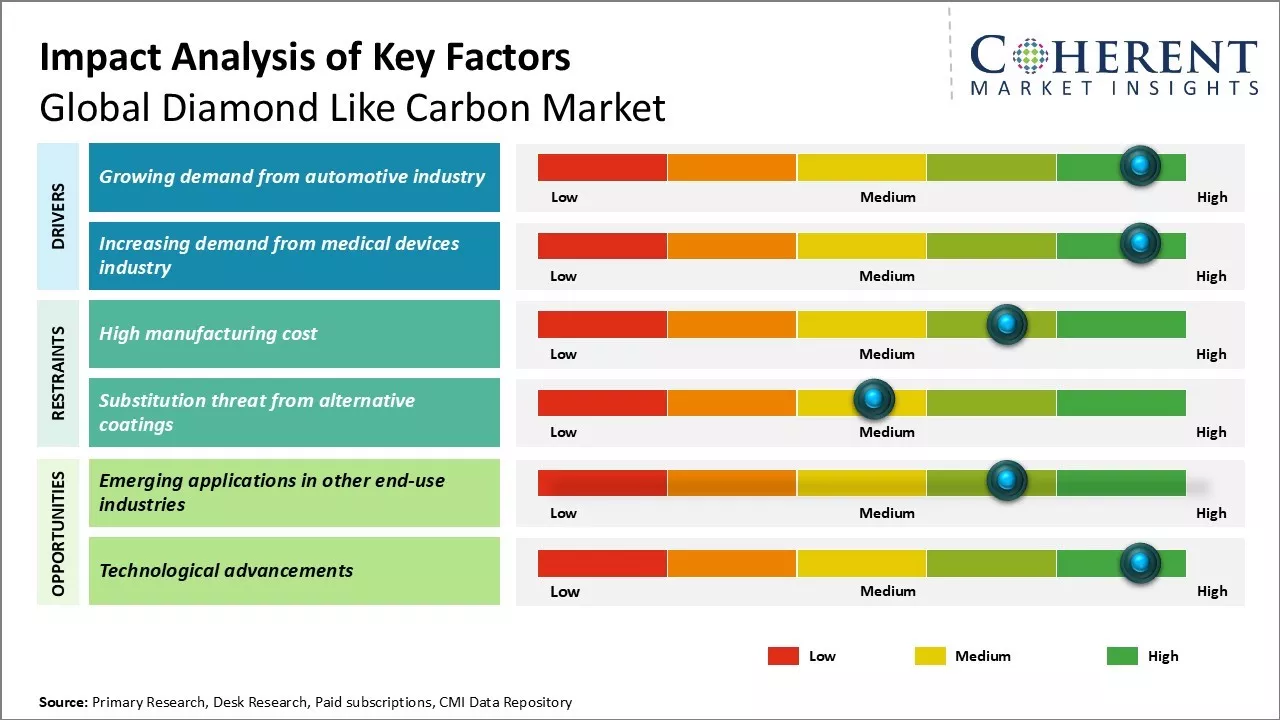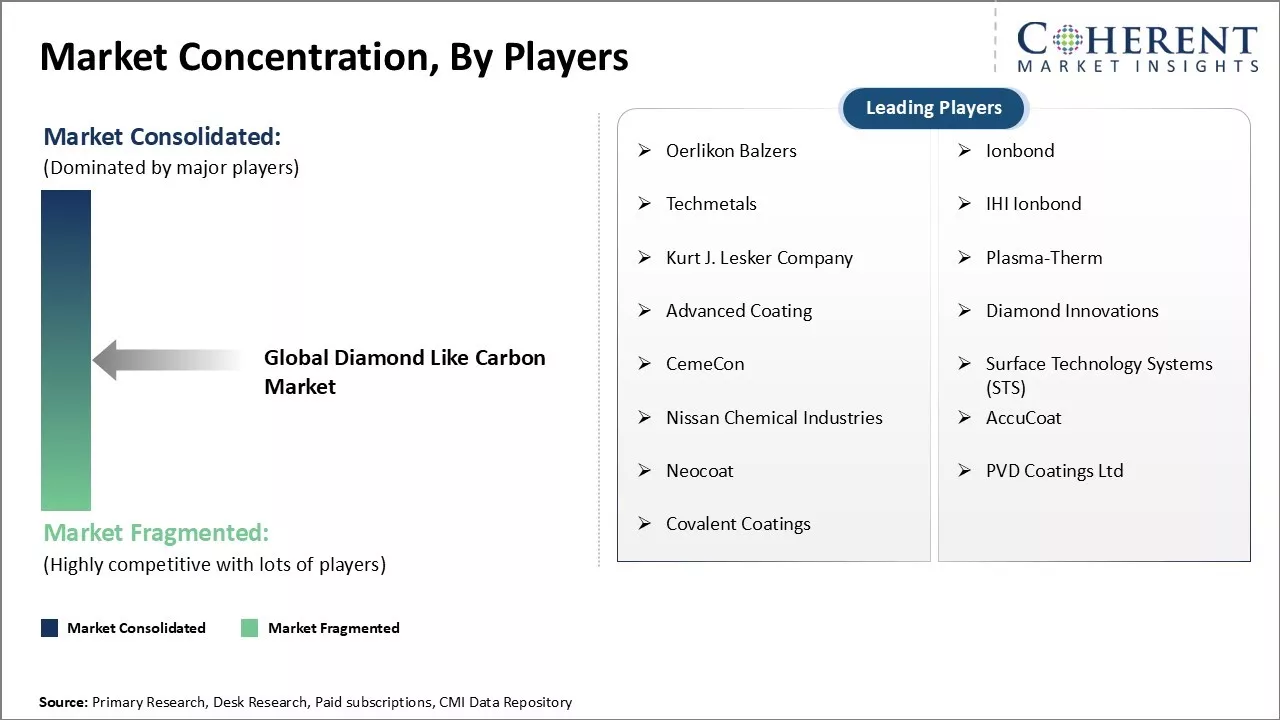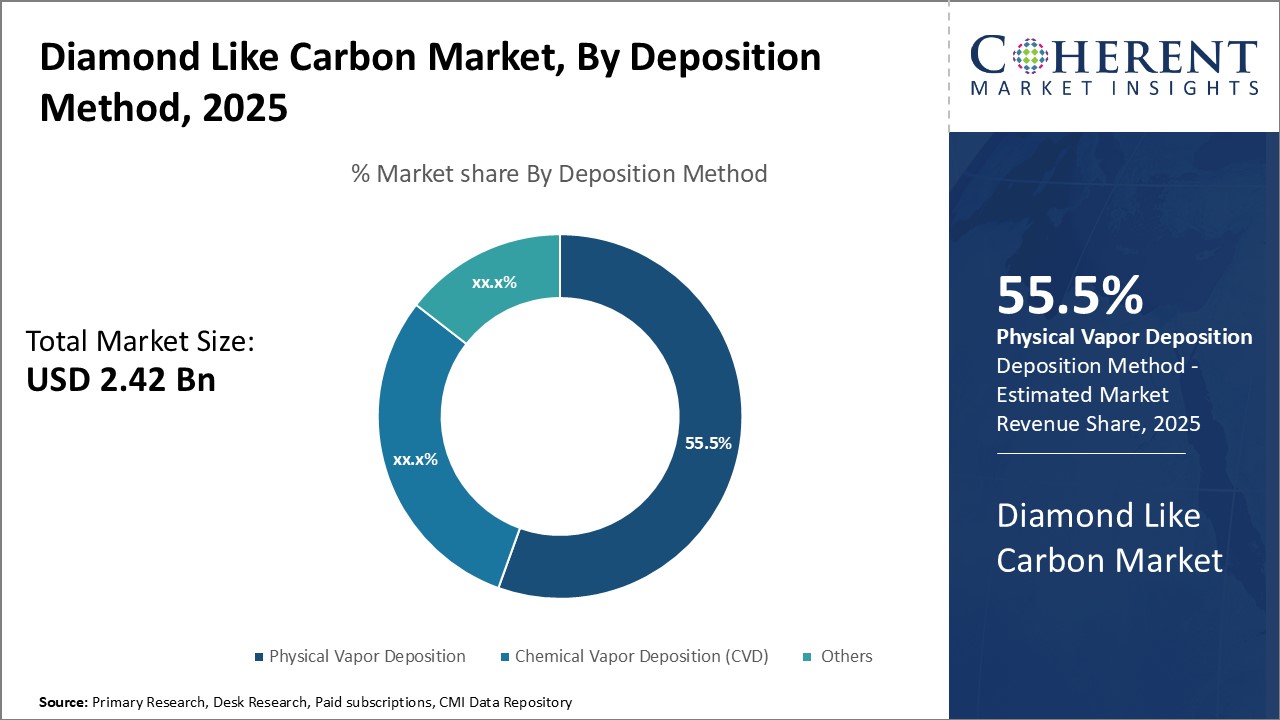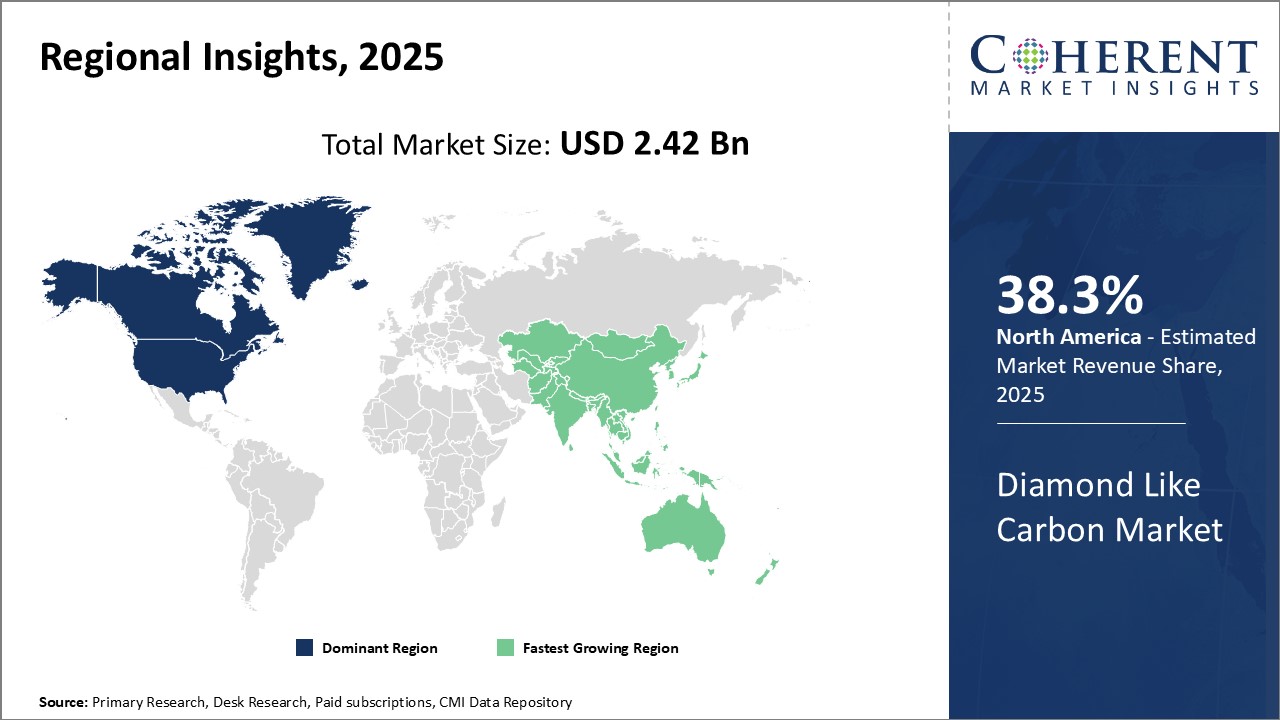Diamond Like Carbon Market Size and Trends
The global diamond like carbon market is estimated to be valued at USD 2.42 Bn in 2025 and is expected to reach USD 3.85 Bn by 2032, exhibiting a compound annual growth rate (CAGR) of 6.8% from 2025 to 2032.

Discover market dynamics shaping the industry: Download Free Sample
The growing industrial automation across various sectors such as automotive, manufacturing, and electronics is expected to drive the demand. Furthermore, diamond like carbon coatings find widespread applications in devices subject to friction and wear including automotive components, cutting tools, and electronic components. Properties such as high hardness, chemical inertness, and low friction coefficient make diamond like carbon ideal for applications requiring protection from wear. Increasing investments by manufacturers to enhance productivity and reduce operational costs through automation are also expected to boost the market growth during the forecast period.
Growing demand from automotive industry
The automotive industry has been a major driving force contributing to the growth of the global diamond like carbon market. DLC films have found widespread use in various automotive components and parts owing to their unique properties such as high hardness, low friction coefficient, and excellent corrosion and wear resistance. Manufacturers have been increasingly adopting DLC coatings in products like engine bearings, gears, door handles, shock absorbers, and other moving parts that require protection against friction and wear over long usage. As DLC enables reducing lubricant needs and enhancing fuel efficiency, more automakers are turning to these coatings to meet stringent emission standards.
One key area where DLC demand is rising strongly is for coating various engine components. Given engines undergo grind stresses and friction during operation, DLC coatings help boost engine performance and lifetime. The coating offers a wear resistance comparable to diamond and acts as an effective barrier against corrosion caused by combustion residues. Leading automotive engine manufacturers have started using DLC for piston rings, cams, engine valves, and other high-pressure components to deliver improved power output and reduced emission levels. At the same time, demand is increasing from manufacturers of brake systems, where the low friction property of DLC plays a vital role in improving braking efficiency and durability. Automakers are also finding DLC useful for transmission components such as gears and bearings to minimize the abrasion of moving metal parts.
The rising sales of electric vehicles and hybrid models present new opportunities for DLC coatings. EV manufacturers adopt DLC films to enhance the efficiency of critical components like motors and batteries. The low friction of DLC helps extend the driving range of EVs while lowering production and maintenance costs. As governments worldwide implement stricter fuel-economy norms to curb emissions, automakers will progressively look at newer technologies like diamond-like carbon coatings that can boost energy efficiency throughout the vehicle. The growing preference for lightweight and high-performance vehicles will further accelerate the DLC demand from the auto sector in the coming years.
Market Concentration and Competitive Landscape

Get actionable strategies to beat competition: Download Free Sample
Increasing demand from medical devices industry
The medical devices industry presents a highly promising growth avenue for diamond-like carbon films. The biocompatibility, chemical inertness, and mechanical strength offered by DLC make it a preferred material for a variety of medical equipment. DLC coatings deliver resistance to corrosion and wear when in contact with body fluids, an essential requirement for implants and surgical tools. The coating eliminates reactions between device materials and tissues, preventing contamination that could infect patients. Leading medical device makers have thus significantly increased their adoption of DLC over the past decade.
Artificial joints and dental implants made of DLC-coated metals have superior load-bearing capabilities and longevity inside the body. As populations age globally, the demand for joint replacement surgeries is thriving internationally. By offering joints that can withstand decades of use without failure, DLC coated implants are revolutionizing orthopedic and dental procedures. Similarly, cardiovascular and neurological devices like stents, guidewires and catheter tubes rely on DLC films to deliver a smooth, bio-compatible surface. This has helped reduce infection risks and complication rates associated with such minimally invasive surgeries.
DLC is also getting widely used as a protective barrier on surgical tools and lab equipment that contact tissues. From biopsy forceps and scalpels to endoscopes and retractors, DLC provides scratch resistance and prevents reactions with bodily fluids. Given surgery tools are meant for single use mostly, the coating guarantees consistent performance of disposable devices at lower costs. Looking forward, as non-invasive diagnostic procedures gain prominence, more medical appliances ranging from lab-on-chip devices to imaging tools will adopt DLC for its bio-safety. With healthcare needs growing exponentially across the world, diamond-like carbon coatings will remain indispensable for manufacturing high-quality, long-lasting medical devices.
Key Takeaways from Analyst:
The major driver for the market's expansion is the increasing demand for DLC coatings from various end-use industries such as automotive, medical devices, and solar panels. DLC coatings enhance product performance and durability which is much needed in advanced manufacturing. Diamond like carbon coatings offer properties such as high hardness, chemical inertness, and excellent thermal conductivity.
While growth opportunities abound, high manufacturing costs associated with chemical vapor deposition process may hinder market potential to a degree. Additionally, the availability of alternative better performing coating materials also remains a challenge. However, continuous R&D towards improving DLC film deposition techniques as well as increasing solar grade applications are expected to unlock new avenues of growth.
North America dominated the global market share primarily due to large presence of automotive OEMs and component suppliers in the region. Within APAC, China leads wholesale adoption of DLC coatings as quality imperatives rise. Asia Pacific is projected to expand at a notable pace during the forecast period and gain market share backed by widespread use across the medical device industry.
Market Challenges: High manufacturing cost
One of the major challenges faced by the global diamond like carbon market is its high manufacturing cost. Diamond like carbon coating has significantly higher production costs as compared to alternative coating materials such as TiO2 and SiC. The high vacuum deposition process and expensive raw materials such as methane that are used for producing DLC coatings contribute to their high manufacturing costs. The costs involved in setting up and maintaining the physical vapor deposition or chemical vapor deposition equipment for DLC coating production is also significant. Furthermore, the multistep and complex processes used for applying even and uniform DLC films over the substrate surfaces enhance the energy costs associated with DLC coating manufacturing. Due to the presence of inexpensive alternatives and increasing price sensitivity among end-use industries, the suppliers of DLC coatings find it difficult to transfer high production costs to consumers. This acts as a major restraint for the global diamond like carbon market.
Market Opportunities: Emerging Applications in Other End-use Industries
The diamond like carbon market is expected to witness new growth opportunities due to its emerging applications in various end-use industries. Traditionally, DLC coatings have been majorly used in applications such as automotive components, aerospace parts, and computer accessories where friction reduction and wear resistance properties were highly required. However, ongoing research and development activities are now exploring the potential of DLC in new and innovative applications as well. For instance, promising trials of DLC coatings have been conducted on medical implants and prostheses to enhance biocompatibility. DLC films are also being tested for their antimicrobial effectiveness on various medical devices. In the energy industry, DLC-coated components can significantly increase the efficiency of engines and turbines by reducing friction. DLC's versatile properties also make it suitable for various microelectronic and optoelectronic applications. Thus, the increasing scope of DLC film usage in other industries beyond the traditional ones will create prosperous opportunities for market players in the future.

Discover high revenue pocket segments and roadmap to it: Download Free Sample
Insights by deposition method: Technology Leadership Drives Physical Vapor Deposition Adoption
In terms of deposition method, the Physical Vapor Deposition (PVD) is expected to contribute 55.5% share of the market in 2025, owing to its technological superiority. PVD allows for greater precision and uniformity of coatings compared to other methods. It enables micrometer thicknesses with angstrom level control, making it well-suited for applications that require extreme nanoscale uniformity like medical devices, semiconductors, and consumer electronics. Additionally, PVD has advanced to allow for coating of complex 3D geometries and large surface areas essential for modern products. Industry leaders have continued driving innovation in PVD technologies such as target designs, magnetron configurations, sputtering powers and advanced nanoparticle deposition. This has solidified PVD's reputation for yielding the highest performance and most durable coatings. Its nanostructured coatings demonstrate unparalleled mechanical, tribological and optical properties attractive to applications demanding quality and reliability. PVD's technology leadership in enabling next-generation designs and precision has made it the deposition method of choice for high-growth sectors and maintains its dominant market share.
Insights by application: Automotive demands drive growth in cutting-edge applications
In terms of application, automotive is expected to contribute 40.1% share of the market in 2025 owing to the industry's rapid adoption of diamond like carbon applications. The automotive sector faces stringent regulatory pressure to boost fuel efficiency and reduce emissions globally. DLC coatings enable lightweighting, lower friction and wear resistance essential to meet these demands. DLC applied to engine components enhances performance, durability and reduces oil consumption. Its scratch and corrosion resistance also make it suitable for car exterior trim. Meanwhile, autonomous and electric vehicles require sophisticated sensors that benefit from DLC's optical clarity and conductivity properties. Cutting-edge automotive technologies will sustain high demand for specialized DLC nanocoating on into the future.
Insights by coating thickness: Thin film functionality drives less than 2 μm adoption
In terms of coating thickness, less than 2 μm is expected to contribute 35% of the market share in 2025 owing to its unique material properties within the nanoregime. Ultra-thin DLC coatings below 2 μm demonstrate enhanced kinetic properties and surface reactivity versus thicker equivalents. These include reduced surface energy, increased density and sp3/sp2 ratios that elevate hardness, lubricity and chemical resilience. As technologies progress towards miniaturization and complexity, the demand grows for functional protective coatings that can be implemented at the nanoscale level. Less than 2 μm DLC films allow for passivation layer applications essential for MEMS, nano-imprint lithography, and next-gen storage media. Their tunable conductivity also shows promise in biosensor and electrochemical applications. The combination of exceptional thin film functionality and compatibility with nanofabrication processes drives uptake of the less than 2 μm segment.
Regional Insights

Need a Different Region or Segment? Download Free Sample
North America has established itself as the dominant region in the global diamond like carbon market. The region is expected to account for 38.3% of the market share in 2025. With the presence of major end-use industries, such as automotive, aerospace & defense, and construction, the demand for diamond like carbon coatings has been consistently high over the years. The region is home to global leaders in these industries such as Boeing, General Motors, Caterpillar, etc. which rely heavily on diamond like carbon coatings for application in components requiring high hardness, strength, and heat resistance.
The automotive industry in the U.S. and Canada has been at the forefront of employing diamond like carbon coatings in engine components and other high wear and friction parts to improve performance and reduce maintenance costs. The growth in adoption of DLC coatings across industries has also led to the presence of large suppliers and coaters in the region which ensures smooth and cost-effective supply chain operations. Multinational coating providers have their major manufacturing facilities located in North America in order to cater to the burgeoning local demand.
On the other hand, the Asia Pacific region has emerged as the fastest growing market for diamond like carbon globally. Countries like China, India, and South Korea are rapidly industrializing which has increased the consumption of DLC coatings across various end-use industries. The automotive sector in China and India especially has been instrumental in propelling the demand as both countries are now among the top auto producers in the world. In addition, the growing aerospace manufacturing clusters in countries like China, Japan, and South Korea have boosted the requirement of diamond like carbon for aircraft components. The presence of cost-competitive DLC coating service providers in China and availability of skilled labor has made the country an important exporter of DLC coated goods such as automotive and mechanical parts. Meanwhile, India has also strengthened its position as a supplier of coated components to major automotive OEMs due to supported government policies promoting the manufacturing sector. The diamond like carbon market in Asia Pacific is estimated to further accelerate due to expanding industrial and manufacturing capacities across the dynamic region.
Market Report Scope
Diamond Like Carbon Market Report Coverage
| Report Coverage | Details | ||
|---|---|---|---|
| Base Year: | 2024 | Market Size in 2025: | USD 2.42 Bn |
| Historical Data for: | 2020 To 2024 | Forecast Period: | 2025 To 2032 |
| Forecast Period 2025 to 2032 CAGR: | 6.8% | 2032 Value Projection: | USD 3.85 Bn |
| Geographies covered: |
|
||
| Segments covered: |
|
||
| Companies covered: |
Oerlikon Balzers, Ionbond, Techmetals, IHI Ionbond, Kurt J. Lesker Company, Plasma-Therm, Advanced Coating, Diamond Innovations, CemeCon, Surface Technology Systems (STS), Nissan Chemical Industries, AccuCoat, Neocoat, PVD Coatings Ltd, and Covalent Coatings |
||
| Growth Drivers: |
|
||
| Restraints & Challenges: |
|
||
Uncover macros and micros vetted on 75+ parameters: Get instant access to report
Diamond Like Carbon Industry News
- In 2023, Nanofilm Technologies, a leading provider of thin-film coatings and surface solutions, announced the acquisition of AxynTeC Dünnschichttechnik, a Germany-based company. This strategic move aims to expand Nanofilm's thin-film coatings portfolio, including its offerings in the field of diamond-like carbon (DLC) hard coatings.
- In 2021, a team of Chinese researchers unveiled AM-III, a groundbreaking super-hard, fullerene-based form of amorphous carbon. This innovative material not only boasts remarkable hardness but also exhibits semiconductor properties, with a bandgap range of 1.5 to 2.2 eV.
*Definition: The global diamond like carbon market consists of companies that manufacture and sell diamond-like carbon coatings and related products. Diamond-like carbon coatings are amorphous carbon films that possess some of the properties of diamond. They are hard, optically transparent, and electrically insulating. Products in this market include diamond-like carbon coated cutting tools, mechanical components, optical windows, and medical devices that benefit from diamond-like carbon's strength, durability, and biocompatibility.
Market Segmentation
- By Deposition Method Insights (Revenue, USD Bn, 2020 - 2032)
-
- Physical Vapor Deposition (PVD)
- Chemical Vapor Deposition (CVD)
- Others
- By Application Insights (Revenue, USD Bn, 2020 - 2032)
- Automotive
- Cutting Tools
- Medical Devices
- Electronics
- Others
- By Coating Thickness Insights (Revenue, USD Bn, 2020 - 2032)
- Less than 2 µm
- 2-5 µm
- More than 5 µm
- By Regional Insights (Revenue, USD Bn, 2020 - 2032)
- North America
- S.
- Canada
- Latin America
- Brazil
- Argentina
- Mexico
- Rest of Latin America
- Europe
- Germany
- K.
- Spain
- France
- Italy
- Russia
- Rest of Europe
- Asia Pacific
- China
- India
- Japan
- Australia
- South Korea
- ASEAN
- Rest of Asia Pacific
- Middle East
- GCC Countries
- Israel
- Rest of Middle East
- Africa
- South Africa
- North Africa
- Central Africa
- North America
- Key Players Insights
- Oerlikon Balzers
- Ionbond
- Techmetals
- IHI Ionbond
- Kurt J. Lesker Company
- Plasma-Therm
- Advanced Coating
- Diamond Innovations
- CemeCon
- Surface Technology Systems (STS)
- Nissan Chemical Industries
- AccuCoat
- Neocoat
- PVD Coatings Ltd
- Covalent Coatings
Share
Share
About Author
Yash Doshi is a Senior Management Consultant. He has 12+ years of experience in conducting research and handling consulting projects across verticals in APAC, EMEA, and the Americas.
He brings strong acumen in helping chemical companies navigate complex challenges and identify growth opportunities. He has deep expertise across the chemicals value chain, including commodity, specialty and fine chemicals, plastics and polymers, and petrochemicals. Yash is a sought-after speaker at industry conferences and contributes to various publications on topics related commodity, specialty and fine chemicals, plastics and polymers, and petrochemicals.
Missing comfort of reading report in your local language? Find your preferred language :
Transform your Strategy with Exclusive Trending Reports :
Frequently Asked Questions
EXISTING CLIENTELE
Joining thousands of companies around the world committed to making the Excellent Business Solutions.
View All Our Clients
